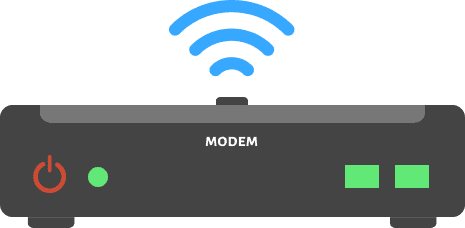There are few technology topics that people get more confused than the difference between modems and routers, but it isn’t that complex if you’re willing to set aside 5 minutes to learn about it. How these devices work technically at a lower level is complicated for the layman, but fortunately, you don’t need to understand any of those details to make the right decisions for your setup.
Let’s focus on the high-level stuff that you need to know.
Modem vs Router
- Modem: is the device that brings the Internet to your home or business from your ISP (Internet Service Provider).
- Router: is a device that you connect to your modem, and then it provides wireless Internet to all of your home devices (TVs, laptops, smartphones, etc.).
There are two common types of modems:
- DSL modems (connected via a phone line).
- Cable modems (connected via a coaxial cable).
Which one you need, depends on which ISP you’re getting your Internet from, and which options you have in your area.

For most homes and businesses, a modem isn’t enough, you need some type of router to distribute your Internet to everyone who needs it.

Technically, you don’t need a router if you only need one of your devices to access your Internet, like a stationary computer. You can just connect that device directly into your modem with a cable. However, most homes and businesses have multiple devices that need Internet access — and preferably wireless. For that purpose, you need a router.
Modem vs. Modem Router
Your ISP sometimes provides you with a modem with a built-in wireless router, this type of hybrid device is called a Modem Router.
If you move to a new home and sign up for a new ISP, they will usually send you a type of modem for your Internet. What you need to know is:
- Is it a regular modem?
- Or is it a modem router?
It’s not always stated clearly on the device you receive which type of modem you got. Some ISP’s provide better get started experiences than others.
A good indicator that it’s a Modem Router is if it has multiple ports for cables and antennas like the graphic you saw earlier.
You can always look up the exact name of your device on the Internet to find out quickly. E.g. mine is called: “Technicolor and the generation is “tg788 v2” This is often faster than looking for answers in a physical manual (which often suck).
If you’re still in doubt contact your ISP and ask them to clear up any confusion before you start wasting time getting frustrated.
If your ISP sends you a regular modem:
- If you’re one person in a small apartment, then you don’t need to get a router, but it’s convenient, assuming you want wireless Internet.
- If you’re a family then you need to buy a router that you connect to your modem, so it can distribute your Internet to everyone.
If your ISP sends you a Modem Router:
- Then it should work fine for the average-sized family and house/apartment, depending on the quality of the device (which can vary).
- If you have a huge house, and or a huge family (10+ people) then you might need to either replace your Modem Router with a more powerful one — or get a powerful router to plug into your modem router. It depends on what your requirements are.
You may also benefit from using a WiFi Extender or several, which are small wireless devices that are designed to eliminate dead zones in your home. You can plug a WiFi Extender into any power outlet, and they will extend coverage and signal strength of your Internet throughout your home.
Rest assured that if your ISP sends you a Modem Router when you subscribe to their service, it is not powerful enough to connect an entire office building, and that‘s probably not what you need either. But what they send you may still not be enough for your specific situation.
There are dozens of routers on the market with different strength levels (and price tags), because no household or company is the same.
How to get it right the first time
It’s important to understand that modems and routers are not black and white topics. Context is important. Start by working with whatever device your ISP sends you. If it’s not sufficient, don’t just go out and buy any cheap router like many people do “because a router is a router, right?” (not it isn’t).
By steering blindly because you can’t be bothered to a bit of research, you’ll often end up getting a router that isn’t powerful enough or waste tons of money on a router that could supply 10x as many people as you need. Router pricing ranges from $10 to $1000’s, depending on the type. Don’t waste your money.
If you have any Internet connection issues do this:
- Contact your ISP and explain your household situation.
- Tell them about the number of people & types of devices that need to be connected.
And any other relevant things like how many floors your house has, how many rooms etc.. Even things like what type of material your house is made of is relevant since some materials are harder for wi-fi signals to penetrate through than others. The more your ISP knows, the more they can help you.
The best advice I can give you based on my experience is that it’s a good idea to get a router that is a bit more powerful than you think you need since it’s better to have a little too much capacity than too little. But you don’t need a router that can connect to the moon, so don’t be silly.